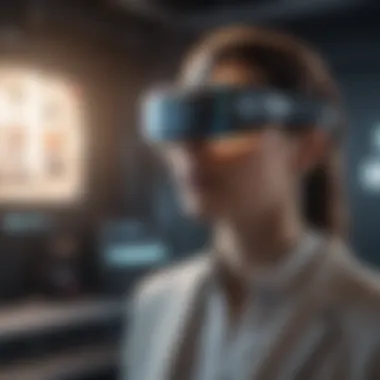Enhancing Data Visualization through Virtual Reality


Intro
The advancement of technology has pushed the boundaries of how we visualize and interact with data. Among these technologies, Virtual Reality (VR) stands out as a formidable tool. It transforms how complex data sets are interpreted, moving beyond traditional screens and into immersive environments. This section discusses the recent advances in VR data visualization, emphasizing its significance in various fields including science, education, and business.
Recent Advances
Latest Discoveries
Researchers and developers are continually uncovering new potentials of VR in data visualization. Studies indicate that VR can enhance cognitive understanding of dense data by presenting it in a 3D space. For example, spatial arrangements allow users to decipher patterns and relationships that would be less visible in 2D representations. This multi-dimensional understanding is crucial when dealing with big data, where relationships can be intricate and complex.
Some notable discoveries include:
- The use of VR simulations in medical training, enabling visualization of anatomical data.
- Enhanced environmental data visualization that allows users to navigate through virtual landscapes to comprehend climate change data.
- Applications in engineering where VR enables the analysis of structural data, leading to safer design processes.
Technological Innovations
Several technological breakthroughs have made VR data visualization more accessible and effective. Innovations such as high-definition graphics, improved motion tracking, and affordable VR headsets are contributing to its rise.
- Graphics Rendering: Improved rendering technologies lead to more realistic visualizations of data.
- User Interaction: Interactive elements such as hand tracking and gesture recognition provide users with the ability to manipulate data intuitively.
- Software Development: Tools like Unity and Unreal Engine empower developers to create sophisticated applications for data visualization with relative ease.
"VR allows data to be experienced rather than just viewed, unlocking new levels of understanding."
Methodology
To fully grasp the impact of VR in data visualization, it’s essential to examine the methodologies employed in this field. The research design and the data collection techniques utilized reveal valuable insights into the efficacy of VR technologies.
Research Design
Research in VR data visualization typically involves both qualitative and quantitative methods. Experimental designs are common, where control groups are used to measure the effectiveness of VR compared to traditional methods. This approach allows researchers to gather data on user engagement and understanding in immersive environments.
Data Collection Techniques
Various techniques are used to collect data, focusing on user experience and comprehension. Surveys and interviews provide qualitative feedback, while performance metrics measure user interaction within the VR environment. Eye-tracking technology can also be implemented to gain insights into user focus areas and cognitive processing during data exploration.
The fusion of virtual reality (VR) and data visualization signifies a transformative advancement in analyzing and interpreting complex data. In this article, we explore this integration, offering insights into its significance and the myriad benefits it brings to various fields. Understanding the essentials of VR data visualization is critical for both academic research and practical applications, making it pertinent for students, researchers, educators, and professionals.
Understanding Virtual Reality
Virtual Reality represents a digital environment created by computer technology, allowing users to immerse themselves in simulated experiences. This capability enables interaction with 3D objects or environments in a way that mimics real-life experiences. The hardware involved typically includes VR headsets, such as the Oculus Rift or HTC Vive, and motion-tracking sensors that facilitate user engagement within the virtual space. As such, understanding VR's foundational elements empowers users to harness its potential for effective data visualization.
The Concept of Data Visualization
Data visualization is the representation of data in graphical formats. It aids individuals in making sense of complex information by providing visual context. Graphs, charts, and maps are common tools used to convey data. The essence lies in transforming raw numbers into comprehensible visual forms. This transformation enhances the ability to recognize patterns, trends, and outliers in data sets. By understanding this concept, we can appreciate how VR enhances and expands the capabilities of traditional data visualization.
Intersection of VR and Data Visualization
The integration of VR with data visualization leads to immersive and intuitive interactions with data. Instead of viewing static graphs on a screen, users can walk through 3D data points, manipulate datasets in a virtual environment, and explore spatial relationships dynamically. This interaction fosters deeper insights and better comprehension, which is crucial for decision-making processes across disciplines. Moreover, as data becomes increasingly complex, the need for advanced visualization methods grows.
"The use of VR in data visualization transforms how data is perceived and interpreted, enabling users to engage with information directly and meaningfully."
With these elements in mind, we can appreciate how VR data visualization serves as a bridge connecting intricate data analyses to actionable insights, enhancing our understanding of both local and global data landscapes.
The Importance of Data Visualization


Data visualization has become a cornerstone of effective communication, especially in a world awash with data. As datasets grow in size and complexity, traditional methods of presenting information often fall short. In this context, data visualization is crucial for making sense of large amounts of information, transforming it into digestible insights. The significance of this process cannot be overstated. It empowers individuals and organizations to comprehend intricate data relationships more intuitively, enabling informed decision-making.
Changing Data into Insights
Turning raw data into actionable insights requires a systematic approach. Data visualization serves as the bridge between numbers and narratives. It idealizes this transformation, allowing the qualitative aspects of data to shine through. By utilizing various visual representations, such as charts, graphs, and maps, it simplifies complex datasets.
For example, tools like Tableau and Microsoft Power BI enable users to create compelling visual stories from data. Such tools help users identify patterns and trends that may be difficult to observe in raw data form. Consequently, an organization can recognize performance gaps or market opportunities that require immediate attention. In academic environments, visualizing research findings helps students understand and synthesize information effectively, promoting deeper learning.
"Good visualization helps us understand not only the data but also the context behind it."
Insights drawn from data can have far-reaching implications. The ability to see connections between different variables can lead to innovative solutions in various fields, from science to business.
Enhancing Decision Making
Data visualization is integral to decision-making processes across numerous sectors. By presenting data in a clear, visual format, it enables stakeholders to grasp complex information quickly. Executives often rely on visual reports to inform their strategic decisions, ensuring they base their actions on accurate and timely information.
Furthermore, narrative-driven data visualization fosters collaboration. Teams can come together to interpret visual data, aligning their understanding and discussions more effectively. This collaborative dynamic can lead to well-rounded decisions that take multiple perspectives into account.
Key considerations in utilizing data visualization for decision-making include:
- Audience Understanding: Tailoring visuals to suit different audiences enhances clarity.
- Clarity Over Complexity: Focusing on what is essential avoids overwhelming the decision-makers.
- Timeliness: Providing real-time data can significantly impact how decisions are made.
As businesses continue to embrace data-driven approaches, effective data visualization will remain essential for making informed decisions that drive success.
Creating Immersive Data Experiences
Creating immersive data experiences is vital in today’s digital landscape. The integration of Virtual Reality (VR) into data visualization transforms how users engage with complex datasets. Immersive environments facilitate a deeper understanding of data by allowing users to visualize, interact, and experience information in three dimensions. This empowers analysts and decision-makers to extract insights that might remain hidden in traditional methods.
Technologies Behind VR Visualization
The technologies behind VR visualization play a crucial role in shaping user experiences. Tools such as head-mounted displays, motion tracking systems, and data integration software work together to create a seamless environment. The use of advanced graphics processing units ensures that data is rendered in real time, allowing for fluid motion and interactivity.
Users can manipulate data sets in an intuitive manner, using gestures or controllers to explore different angles and perspectives. This direct interaction provides an immediate feedback loop, enhancing comprehension significantly. The technology behind these experiences must be reliable and effective in delivering high-quality visuals while maintaining a high frame rate to prevent motion sickness.
Types of VR Data Visualization
Several types of VR data visualization enhance data interpretation. Understanding their unique characteristics is essential for choosing the right approach in various contexts.
Three-dimensional Models
Three-dimensional models offer a spatial understanding of data. These models enable users to examine data points within a realistic space, making patterns and relationships more obvious. The key characteristic of these models is their ability to convey volume and depth, which is often lacking in other visualization forms.
One beneficial aspect of three-dimensional models is their ability to visualize large datasets that are complex and multi-dimensional. Users can rotate the model, zoom in, and interact with different layers of information. However, a downside is that some users may find navigating these models challenging, especially if they lack prior experience with 3D environments.
Interactive Dashboards
Interactive dashboards allow users to engage with real-time data seamlessly. These dashboards provide users with the capacity to customize their views and drill down into specific metrics or data segments. The key aspect of interactive dashboards is their functionality; they allow for a dynamic exploration of data driven by the user’s needs.
The unique feature of these dashboards lies in their ability to facilitate quick comparisons and understanding of different data variables. Users can instantly visualize changes over time or between categories. However, if poorly designed, these dashboards can lead to confusion, as too much information can be overwhelming for the user.
Virtual Tours
Virtual tours offer a compelling way to visualize data. They transport users through a narrative experience, showcasing datasets in context. The strength of virtual tours lies in their ability to tell a story through data, which can enhance retention and understanding.
The distinct characteristic of virtual tours is their guided experience; users are led through data points in a structured manner. This can be especially beneficial in educational settings, as it allows learners to grasp complex concepts step-by-step. However, the downside may include limitation in user control, as users might prefer to navigate freely rather than follow a predetermined path.


Applications of VR Data Visualization
The applications of VR data visualization are vast and impactful, enhancing how we interpret and analyze data across various fields. By leveraging the immersive features of virtual reality, professionals can interact with data in a more insightful and intuitive way. This transformation is not just a technological advancement; it signifies a fundamental shift in the approach to data interpretation.
Scientific Research
In the realm of scientific research, VR data visualization serves as a powerful tool for analysis and representation. Researchers can visualize complex datasets in three-dimensional formats, which helps in discerning patterns and relationships that might not be evident in traditional two-dimensional charts or graphs. For instance, in fields like genomics or astrophysics, vast amounts of data can be manipulated in real time, allowing for a more comprehensive understanding of the subject matter.
Moreover, immersive simulations can enhance experimental setups, enabling scientists to test hypotheses in virtual environments. This capability accelerates the pace of discovery by allowing for rapid iteration and experimentation without the constraints of laboratory settings.
Healthcare
The healthcare sector is another area where VR data visualization shows tremendous potential. Medical professionals can visualize patient data in an interactive manner, which allows for better diagnosis and treatment planning. For example, surgeons can explore 3D models of organs or tumors before performing procedures, leading to more precise operations. Furthermore, VR technologies can aid in medical training, providing students and professionals with realistic scenarios for practicing surgical techniques or emergency responses.
This application not only improves patient outcomes but also enhances the training experience for medical practitioners, bridging the gap between theoretical knowledge and practical application.
Business Intelligence
In business intelligence, VR data visualization facilitates better decision-making by presenting complex business data in engaging formats. Interactive dashboards enable executives and analysts to dive deeply into key performance indicators and metrics, allowing for a more nuanced understanding of business operations.
Analysts can use VR tools to build scenarios that demonstrate how different variables influence outcomes. This immersive approach helps teams visualize projections and trends, making it easier to strategize and plan for the future. Additionally, collaborative spaces within VR can enhance team discussions, making data-centered decisions more participatory and comprehensive.
Education and Training
In educational settings, VR data visualization serves as a revolutionary approach to teaching and learning. Students can engage with data in a hands-on manner, turning abstract concepts into tangible experiences. For instance, students studying geography can navigate through virtual maps while analyzing demographic data or climate patterns.
This method promotes active learning, as students participate in simulations that enhance retention and understanding. Furthermore, educators can utilize VR to create custom experiences that align with their curricula, making learning more relevant and stimulating for students.
User Experience in VR Data Visualization
Key elements in user experience design for VR data visualization include usability, immersion, and feedback.
Cognitive Load Considerations
Cognitive load refers to the amount of mental effort being used in the working memory. In VR data visualization, cognitive load can greatly impact how users interpret and understand visual data representations. When information is presented in a complex manner, it can overwhelm users, leading to confusion and misinterpretation.
Strategies to manage cognitive load in VR:
- Simplified Designs: Utilizing clear and concise graphics can help prevent cognitive overload. This means prioritizing essential data and eliminating unnecessary details.
- Progressive Disclosure: Gradually revealing data to users can help them grasp complex concepts step-by-step, reducing the risk of information overload.
- User-Controlled Exploration: Allowing users to navigate through the data at their own pace can enhance understanding. Users should feel empowered to dive deeper into the data only as they feel ready.
Understanding how cognitive load affects user experience is essential. By designing VR data visualization environments with manageable cognitive demands, users can make better use of their cognitive resources to focus on interpreting the data.
Navigational Challenges
Navigational challenges are another crucial aspect of user experience in VR data visualization. Effective navigation allows users to explore the data intuitively, enabling them to uncover insights easily. However, poorly designed navigation can lead to frustration and disengagement.
Common navigational challenges include:
- Orientation Issues: Users may struggle to understand where they are in the virtual space. This can happen especially in complex visual representations. Clear reference points can aid users in maintaining spatial awareness.
- Interaction Complexity: If interactions are overly complicated or non-intuitive, users may find it difficult to engage with the data. Simplifying interactions through familiar controls can enhance navigation.
- Feedback Mechanism: Users need to receive clear feedback on their actions within the VR space. This includes visual cues or auditory signals to confirm their interactions.
To address these challenges, it's important to conduct user testing and iterate on design solutions. Engaging users in the design process ensures that the VR experience meets their needs and expectations. By prioritizing user-centered navigation, data visualization becomes more accessible and meaningful.
"User experience in VR data visualization is not ancillary; it is foundational to transforming data into actionable insights."
Challenges in VR Data Visualization


The intersection of virtual reality and data visualization presents significant opportunities, yet it is also fraught with challenges. Understanding these hurdles is crucial for developers, researchers, and practitioners working in this rapidly evolving field. The complexity of integrating data visualization with immersive technology prompts a need for awareness regarding its limitations, the potential for overwhelming users, and accessibility concerns.
Technical Limitations
Despite its potential, implementing VR data visualization is limited by current technology. Hardware requirements may restrict access for some users, as high-performance computers and VR headsets are prerequisites for an optimal experience. Moreover, software compatibility issues can arise when integrating existing data visualization tools with VR platforms. High-resolution graphics are needed to present complex data effectively, which can demand processing power that is not universally available.
Another aspect of technical limitations lies in the design of the virtual environment. Developers must consider the fidelity of the data representation. Low-quality graphics can lead to misinterpretation of data. Furthermore, latency issues can disrupt the user experience, making it difficult for viewers to interact seamlessly with the data they examine. These technical aspects must be addressed to ensure the technology serves its intended purpose effectively.
Data Overload
Data overload is another significant challenge in virtual reality environments. While VR provides a platform for presenting large data sets in an engaging way, the immersive nature can lead to cognitive overload. When too much information is rendered within a space, users may find it difficult to focus on key insights or make meaningful conclusions.
Achieving the right balance between detail and clarity is essential. Effective VR data visualization should allow for filtering options that enable users to interactively adjust the data displayed. This interactivity helps maintain focus, leading to greater comprehension and informed decision-making. However, developers must tread carefully to avoid overwhelming users with excessive data points or complex interactions.
"The richness of data visualization in virtual reality must be balanced with usability to maximize its potential for insight."
Accessibility Issues
Accessibility in VR data visualization is a critical issue that needs deliberation. Not all users have the same comfort level or capability with immersive technology. Individuals with various impairments may find it challenging to engage with VR experiences, especially if adequate measures are not taken to accommodate their needs.
It is imperative for developers to incorporate features that enhance inclusivity. This may involve providing alternative interfaces for users with different abilities, ensuring that the experience is navigable without reliance solely on physical interaction. Providing options for subtitles, audio descriptions, and simplified controls can make VR data visualization more accessible.
Future Directions in VR Data Visualization
The evolution of virtual reality in data visualization presents numerous exciting opportunities. As technology continues to advance, the intersection of VR and data presents new methodologies that can significantly transform how we interpret complex datasets. This section aims to highlight key developments that are shaping the future of VR data visualization, focusing on emerging trends and the role of artificial intelligence.
Emerging Trends
Several trends are gaining momentum in VR data visualization that promise to impact various sectors. These trends include:
- Integration of Mixed Reality: Combining virtual reality with augmented reality leads to enhanced interactive experiences. This integration allows users to view and manipulate data more intuitively while interacting with the physical environment around them.
- Increased Focus on Interactivity: Users are demanding more interactive options in data visualization. This trend encourages the design of more engaging dashboards that allow users to manipulate variables in real-time, leading to deeper insights.
- Enhanced Collaboration Features: As remote work becomes more prevalent, there is a growing need for collaborative VR environments. Tools are being designed to enable teams to visualize and explore data together, regardless of their physical locations.
- Real-Time Data Processing: The combination of faster processing technologies and improved hardware capabilities allows for real-time data updates in VR. This trend is crucial for sectors such as finance and healthcare, where timely insights can significantly impact decision-making.
These trends not only enhance the analytical capabilities of organizations but also create opportunities for further research and innovation in the field of data visualization.
The Role of Artificial Intelligence
Artificial intelligence is taking a central role in the evolution of VR data visualization. This intersection benefits greatly from AI in several ways:
- Automated Data Analysis: AI can process large volumes of data quickly and accurately. By leveraging machine learning algorithms, it can identify patterns, anomalies, and trends that might not be immediately visible.
- Personalized Experiences: AI technologies can create personalized data visualization experiences based on individual user behavior and preferences. By understanding how users interact with data, AI can tailor experiences to maximize engagement and comprehension.
- Intelligent Feedback Mechanisms: Implementing AI in VR environments allows for continuous feedback and adjustment. This capability means that as users interact with the data, the system can adapt in real-time to improve user engagement and effectiveness.
- Natural Language Processing: Integrating natural language processing enables users to inquire about data using conversational language. This feature can greatly simplify interactions with complex datasets, making data visualization more accessible.
In summary, the future of VR data visualization is shaped by ongoing technological advancements and the integration of AI. By understanding these emerging trends and leveraging AI, organizations can unlock new ways to interpret and visualize data, ultimately enhancing decision-making and insight generation in various domains.
The convergence of virtual reality and artificial intelligence promises to deliver unprecedented capabilities in data visualization.
For further reading on these trends, consider exploring resources from Wikipedia, Britannica, and engaging discussions on Reddit.
Finale
Recap of Key Insights
The intersection of virtual reality and data visualization presents a unique approach to understanding complex data sets. Key insights from the article include:
- Enhanced Comprehension: VR allows users to interact with data in a three-dimensional space. This enhances their ability to comprehend large data sets intuitively.
- Real-World Applications: Various sectors such as healthcare, education, and business intelligence leverage VR to create immersive data experiences. These applications showcase how VR can enrich the data interpretation process.
- User Experience: Considerations concerning cognitive load and navigational challenges are fundamental. An effective VR data visualization interface must address these concerns to ensure ease of use and maximize insights.
- Future Directions: Emerging trends indicate that the integration of artificial intelligence with VR data visualization will lead to more sophisticated analysis capabilities, enabling faster decision-making processes.
The Impact of VR on Data Interpretation
Virtual reality fundamentally alters how users interpret data. By providing immersive environments, it encourages deep engagement with the information presented. Traditional graphical representations often fail to convey the full extent or complexity of the data. VR offers a more engaging solution, where users can manipulate data visually and spatially, leading to a deeper understanding.
Moreover, VR visualization can represent abstract relationships and patterns in data that might otherwise be overlooked. By stepping into a virtual environment, users can gain insights not only from numerical values but also from the spatial relationships and interactions amongst data points. This multi-faceted approach significantly enhances analytical capabilities and fosters innovative thinking.
Ultimately, the impact of virtual reality on data interpretation extends beyond improving how we view data; it reshapes the very foundation of decision-making processes across diverse fields.















